Algebraic Point Projection for Immersed Boundary Analysis on Low Degree NURBS Curves and Surfaces
Abstract
:1. Introduction
2. Literature Review
- Seek an initial point or segment.
- Iterate by Newton–Raphson scheme until convergence.
3. Background on Algebraic Level Sets
- Accurate measure of distance locally near the curve/surface
- Monotonic function of Euclidean (exact) distance
- Sufficiently smooth for engineering applications
- Efficiently obtained without numerical iterations for points close to the curve/surface
3.1. Implicitization of a Parametric Curve
3.2. Boolean Operations by R-Functions
- R-conjunction, equivalent to Boolean intersection:
- R-disjunction, equivalent to Boolean union:
3.3. Normalization and Composition of Algebraic Level Sets
3.4. Extension to NURBS Surface
| Algorithm 1 Algebraic level sets algorithm. |
|
3.5. Time Complexity of the Algebraic Level Sets Algorithm
4. Methodology of Algebraic Point Projection
4.1. Algebraic Point Projection for a NURBS Curve
- Exact at any point on the curve or surface, i.e., exact point inversion
- Controllable accuracy when projected from points near the curve or surface
- Efficient, non-iterative, and non-recursive solution procedure
- Footpoints are continuous even near curve segments with high curvature
- Valid solutions even when projected onto curves with only continuity
4.1.1. First Order Algebraic Point Projection in Physical Space
- Component matrices , , and are constant for a given rational parametric curve. Therefore, they can be pre-computed and repeatedly used at a point .
- Only matrix needs to be factorized, and the procedure extensively reuses the products and when computing and .
- For a Bezout matrix of size , where p is the degree of the rational parametric curve, the typical computational cost is low since p is usually small in engineering applications.
4.1.2. Second Order Algebraic Point Projection in Physical Space
4.1.3. Improvement to First Order Algebraic Point Projection
4.1.4. Improvement to Second Order Algebraic Point Projection
4.1.5. Inversion to Parametric Space
4.2. Extension to NURBS Surfaces
4.2.1. Projection in Physical Space
4.2.2. Inversion to Parametric Space
4.3. Time Complexity of the Algebraic Point Projection Algorithm
| Algorithm 2 Algebraic point projection algorithm. |
|
5. Results and Discussion
- Decompose NURBS curve or surface and get the corresponding implicit form for each Bézier entity.
- Construct algebraic level sets for the decomposed Bézier entities.
- Compose level sets on Bézier patches using R-functions to construct algebraic level sets on the NURBS entity.
- Find nearest Bézier entity for a given quadrature point in the domain.
- Project test point on the nearest Bézier entity to get foot point in the physical space.
- Apply point inversion and decide if recursive projection is needed.
- Obtain global parametric solution by scaling the parameter value of the Bézier entity to that of the NURBS entity.
5.1. Curve Tests
5.2. Surface Tests
6. Conclusions
Author Contributions
Funding
Acknowledgments
Conflicts of Interest
References
- Mortenson, M. Geometric Modeling; John Wiley & Sons: New York, NY, USA, 1985. [Google Scholar]
- Piegl, L.; Tiller, W. Parametrization for surface fitting in reverse engineering. Comput. Aided Des. 2001, 33, 593–603. [Google Scholar] [CrossRef]
- Peskin, C.S. Flow patterns around heart valves: A numerical method. J. Comput. Phys. 1972, 10, 252–271. [Google Scholar] [CrossRef]
- Natekar, D.; Zhang, X.; Subbarayan, G. Constructive solid analysis: A hierarchical, geometry-based meshless analysis procedure for integrated design and analysis. Comput. Aided Des. 2004, 36, 473–486. [Google Scholar] [CrossRef]
- Hughes, T.J.; Cottrell, J.A.; Bazilevs, Y. Isogeometric analysis: CAD, finite elements, NURBS, exact geometry and mesh refinement. Comput. Methods Appl. Mech. Eng. 2005, 194, 4135–4195. [Google Scholar] [CrossRef] [Green Version]
- Tambat, A.; Subbarayan, G. Isogeometric enriched field approximations. Comput. Methods Appl. Mech. Eng. 2012, 245-246, 1–21. [Google Scholar] [CrossRef]
- Wriggers, P.; Zavarise, G. Computational Contact Mechanics; John Wiley & Sons: New York, NY, USA, 2004. [Google Scholar]
- De Lorenzis, L.; Temizer, I.; Wriggers, P.; Zavarise, G. A large deformation frictional contact formulation using NURBS-based isogeometric analysis. Int. J. Numer. Methods. Eng. 2011, 87, 1278–1300. [Google Scholar] [CrossRef] [Green Version]
- Bazilevs, Y.; Calo, V.M.; Zhang, Y.; Hughes, T.J. Isogeometric fluid–structure interaction analysis with applications to arterial blood flow. Comput. Mech. 2006, 38, 310–322. [Google Scholar] [CrossRef]
- Tambat, A.; Subbarayan, G. Simulations of arbitrary crack path deflection at a material interface in layered structures. Eng. Fract. Mech. 2015, 141, 124–139. [Google Scholar] [CrossRef]
- Song, T.; Upreti, K.; Subbarayan, G. A sharp interface isogeometric solution to the Stefan problem. Comput. Methods Appl. Mech. Eng. 2015, 284, 556–582. [Google Scholar] [CrossRef]
- Ma, Y.L.; Hewitt, W. Point inversion and projection for NURBS curve and surface: Control polygon approach. Comput. Aided Geom. Des. 2003, 20, 79–99. [Google Scholar] [CrossRef]
- Chen, X.D.; Su, H.; Yong, J.H.; Paul, J.C.; Sun, J.G. A counterexample on point inversion and projection for NURBS curve. Comput. Aided Geom. Des. 2007, 24, 302. [Google Scholar] [CrossRef] [Green Version]
- Selimovic, I. Improved algorithms for the projection of points on NURBS curves and surfaces. Comput. Aided Geom. Des. 2006, 23, 439–445. [Google Scholar] [CrossRef]
- Chen, X.D.; Yong, J.H.; Wang, G.; Paul, J.C.; Xu, G. Computing the minimum distance between a point and a NURBS curve. Comput. Aided Des. 2008, 40, 1051–1054. [Google Scholar] [CrossRef] [Green Version]
- Hoschek, J.; Lasser, D.; Schumaker, L.L. Fundamentals of Computer Aided Geometric Design; AK Peters: Natick, MA, USA, 1993. [Google Scholar]
- Hartmann, E. On the curvature of curves and surfaces defined by normalforms. Comput. Aided Geom. Des. 1999, 16, 355–376. [Google Scholar] [CrossRef]
- Hu, S.; Sun, J.; Jin, T.; Wang, G. Computing the parameters of points on NURBS curves and surfaces via moving affine frame method. J. Softw. 2000, 11, 49–53. [Google Scholar]
- Hu, S.M.; Wallner, J. A second-order algorithm for orthogonal projection onto curves and surfaces. Comput. Aided Geom. Des. 2005, 22, 251–260. [Google Scholar] [CrossRef] [Green Version]
- Liu, X.M.; Yang, L.; Yong, J.H.; Gu, H.J.; Sun, J.G. A torus patch approximation approach for point projection on surfaces. Comput. Aided Geom. Des. 2009, 26, 593–598. [Google Scholar] [CrossRef] [Green Version]
- Li, X.; Wu, Z.; Pan, F.; Liang, J.; Zhang, J.; Hou, L. A Geometric Strategy Algorithm for Orthogonal Projection onto a Parametric Surface. J. Comput. Sci. Technol. 2019, 34, 1279–1293. [Google Scholar] [CrossRef]
- Piegl, L.; Tiller, W. The NURBS Book; Springer Science & Business Media: New York, NY, USA, 1997. [Google Scholar]
- Upreti, K.; Song, T.; Tambat, A.; Subbarayan, G. Algebraic distance estimations for enriched isogeometric analysis. Comput. Methods Appl. Mech. Eng. 2014, 280, 28–56. [Google Scholar] [CrossRef]
- Upreti, K.; Subbarayan, G. Signed algebraic level sets on NURBS surfaces and implicit Boolean compositions for isogeometric CAD–CAE integration. Comput. Aided Des. 2017, 82, 112–126. [Google Scholar] [CrossRef]
- Sederberg, T. Implicit and Parametric Curves and Surfaces for Computer Aided Geometric Design. Ph.D. Thesis, Purdue University, West Lafayette, Indiana, 1983. [Google Scholar]
- Biswas, A.; Shapiro, V. Approximate distance fields with non-vanishing gradients. Graph. Models 2004, 66, 133–159. [Google Scholar] [CrossRef]
- Rvachev, V. On the analytical description of some geometric objects. Rep. Ukr. Acad. Sci. 1963, 153, 765–767. [Google Scholar]
- Shapiro, V. Theory of R-Functions and Applications: A Primer; Technical Report TR91-1219; Cornell University: Ithaca, NY, USA, 1991. [Google Scholar]
- Abhyankar, S. Algebraic Geometry for Scientists and Engineers; American Mathematical Society: Providence, RI, USA, 1990; Volume 35. [Google Scholar]
- Goldman, R.; Sederberg, T.; Anderson, D. Vector elimination: A technique for the implicitization, inversion, and intersection of planar parametric rational polynomial curves. Comput. Aided Geom. Des. 1984, 1, 327–356. [Google Scholar] [CrossRef]
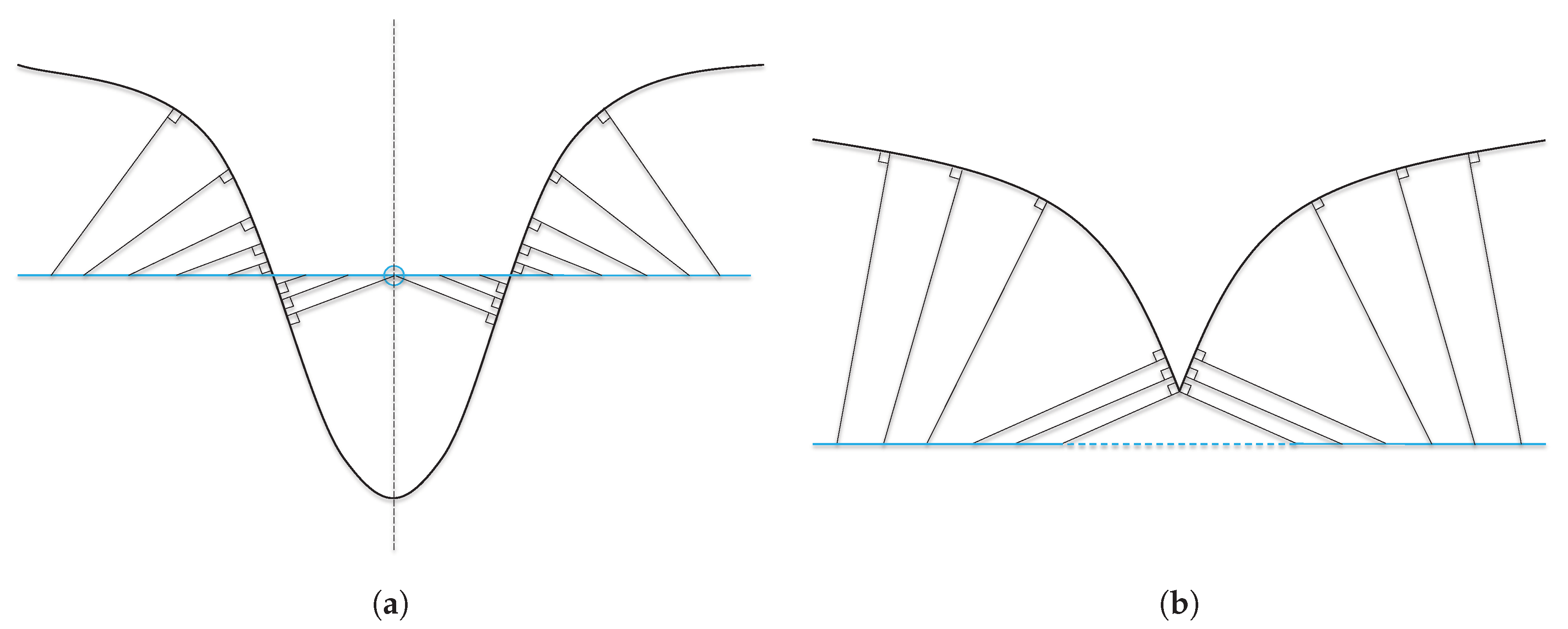
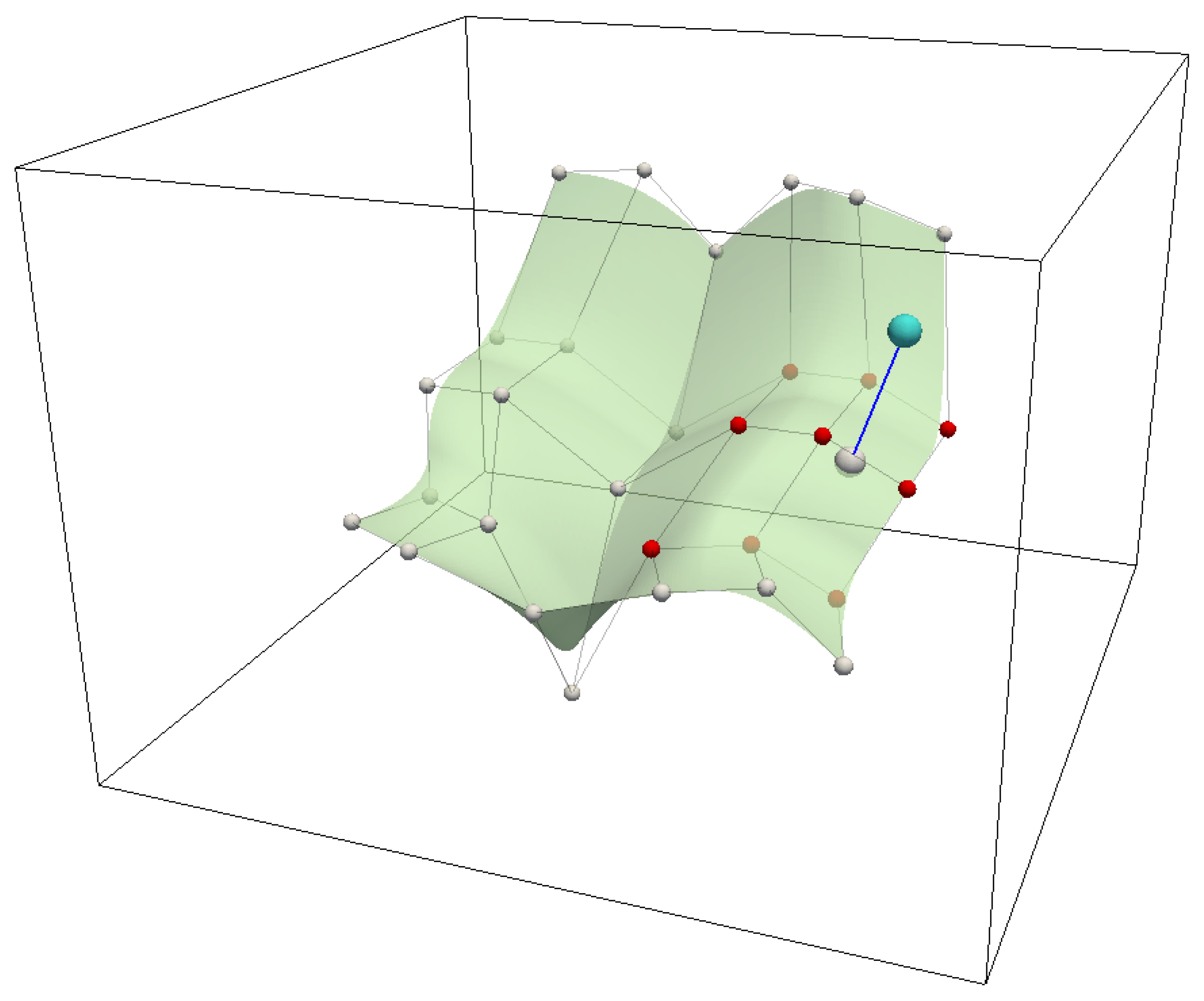
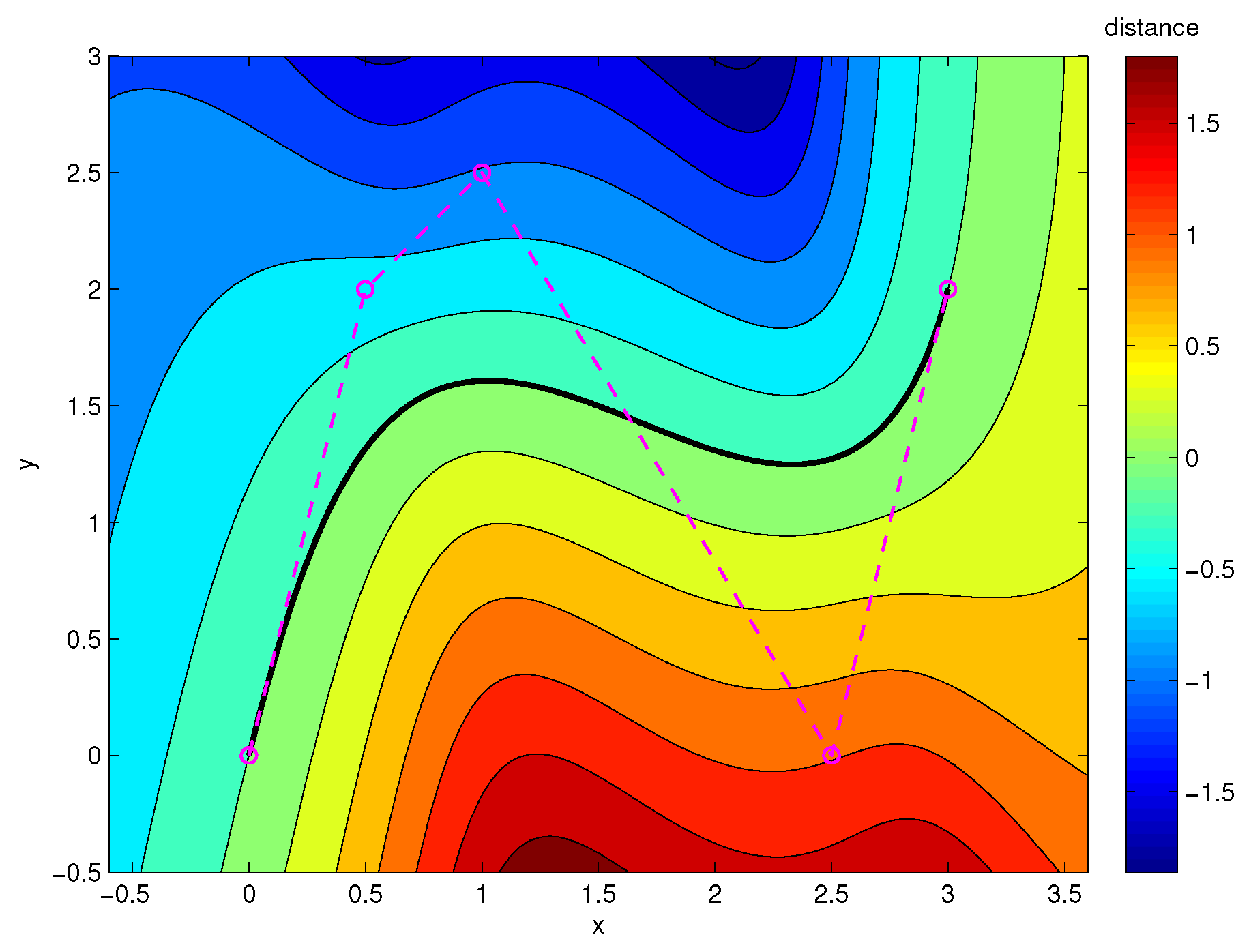
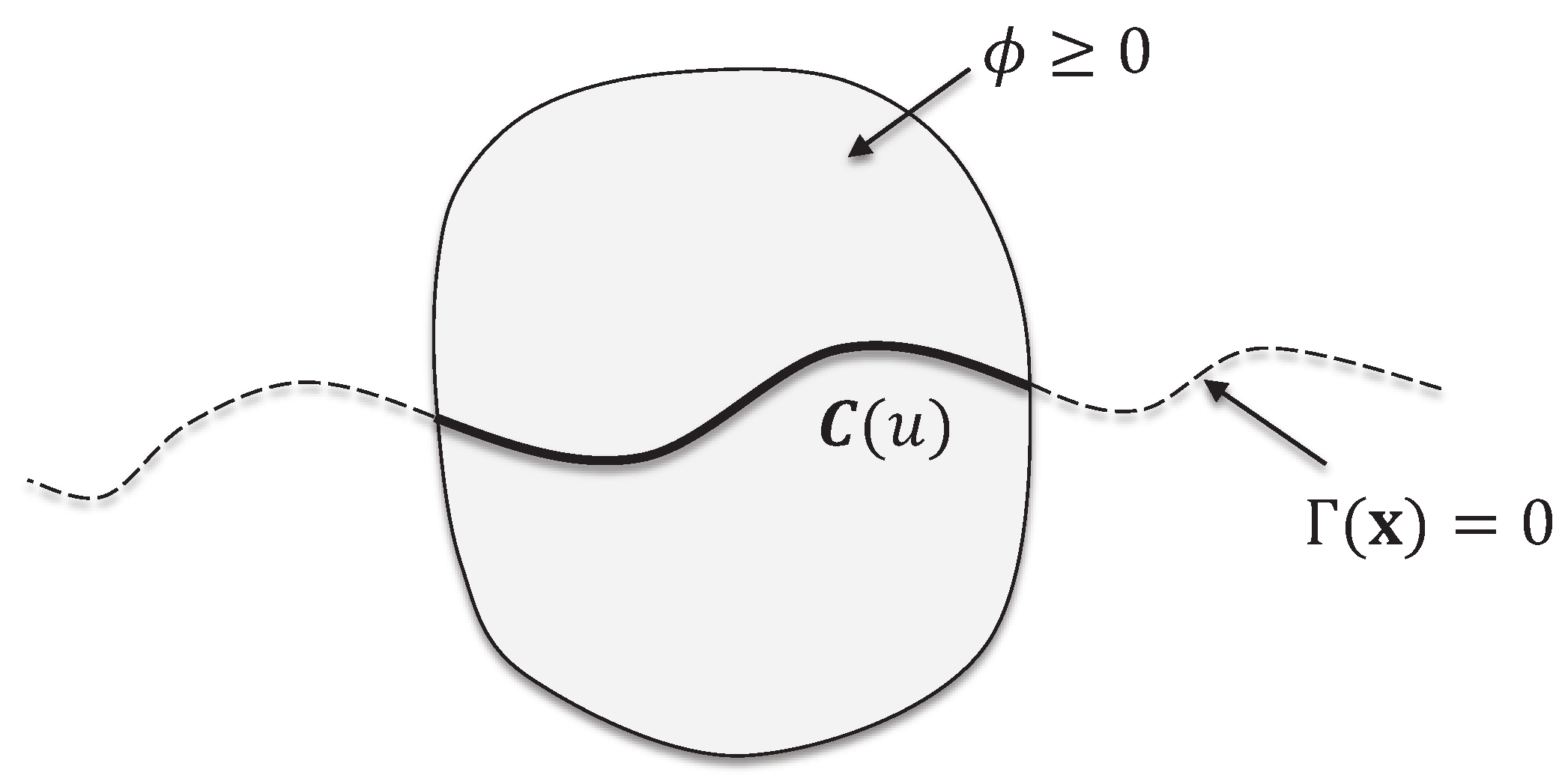
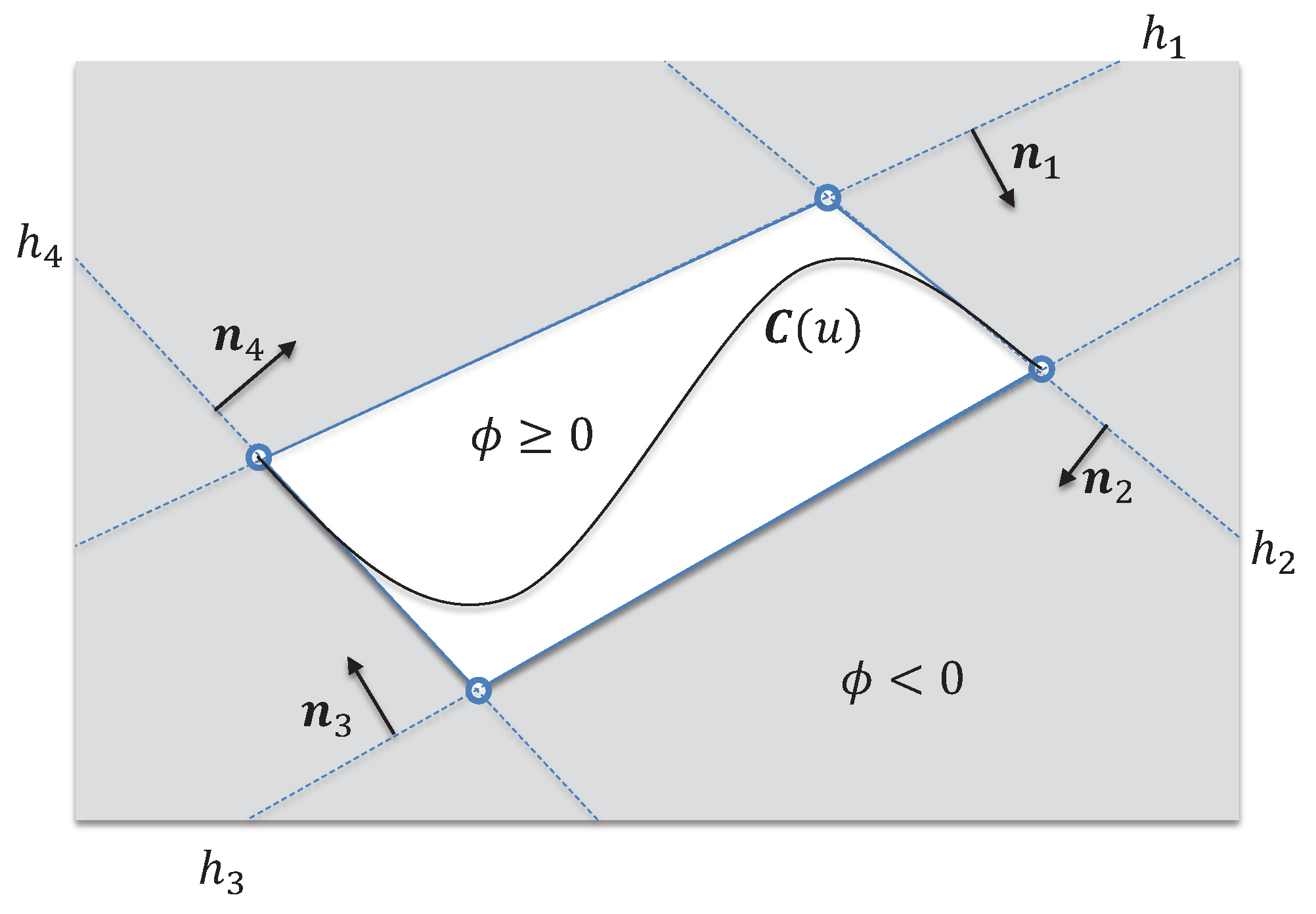
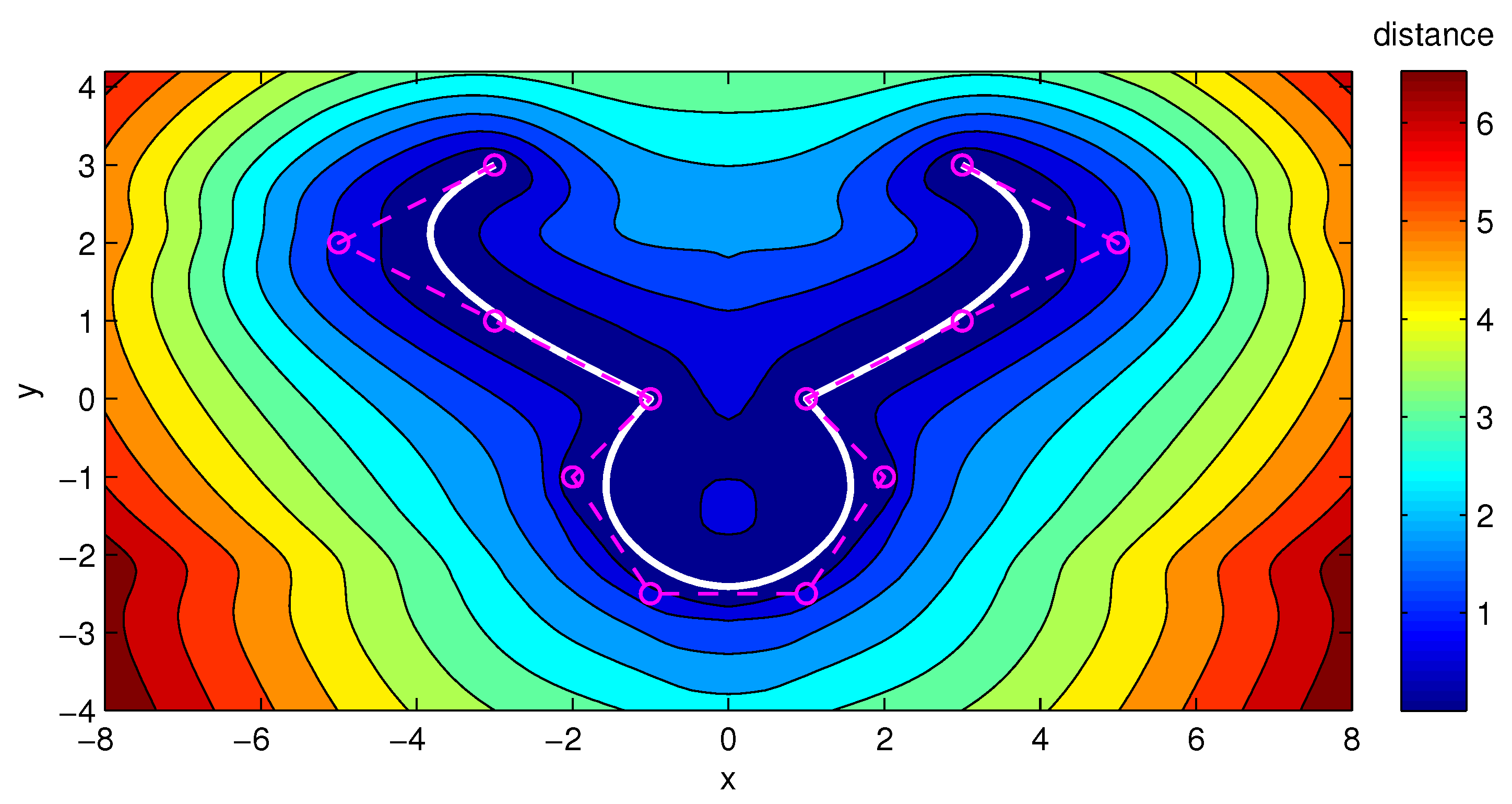
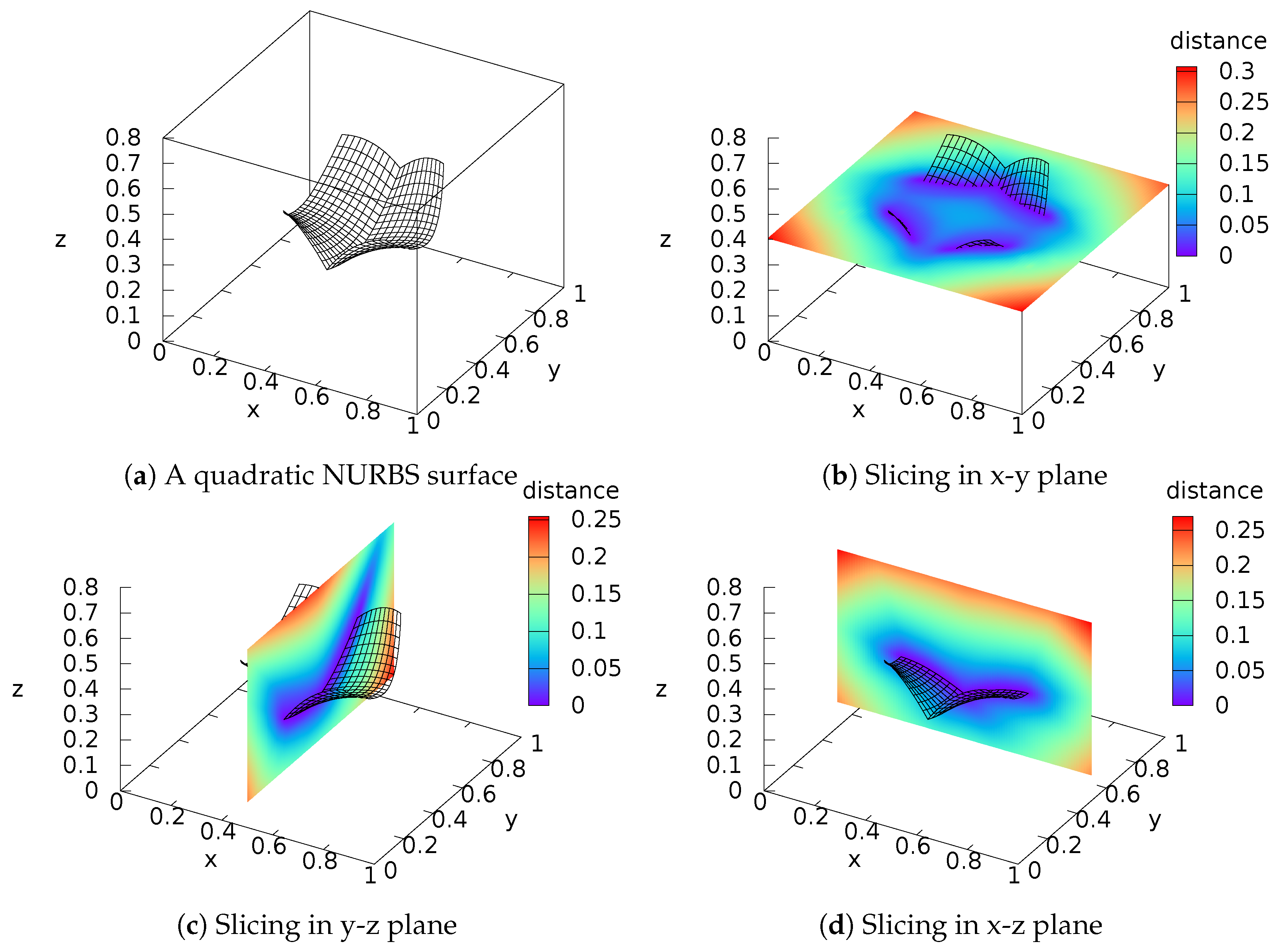
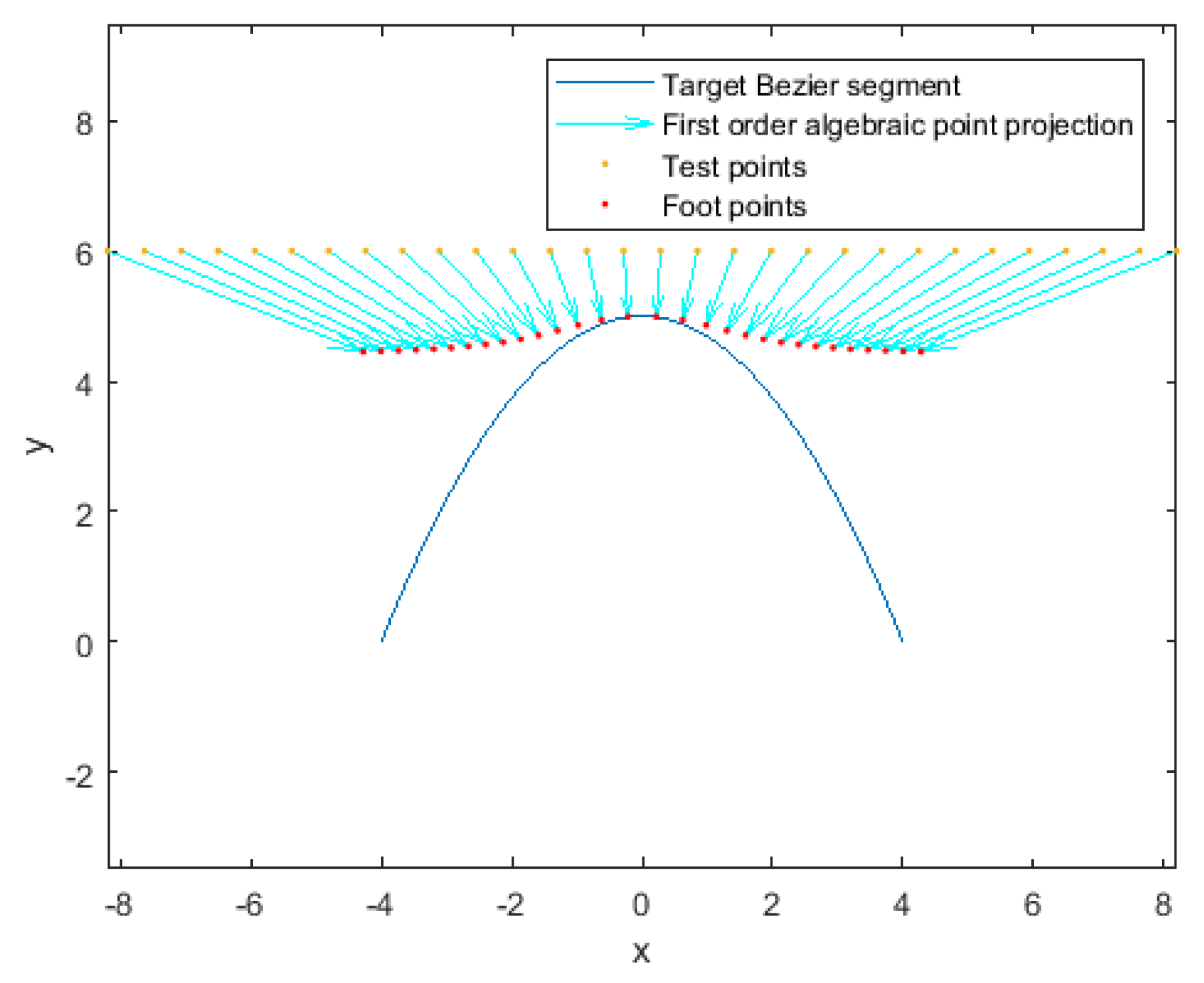
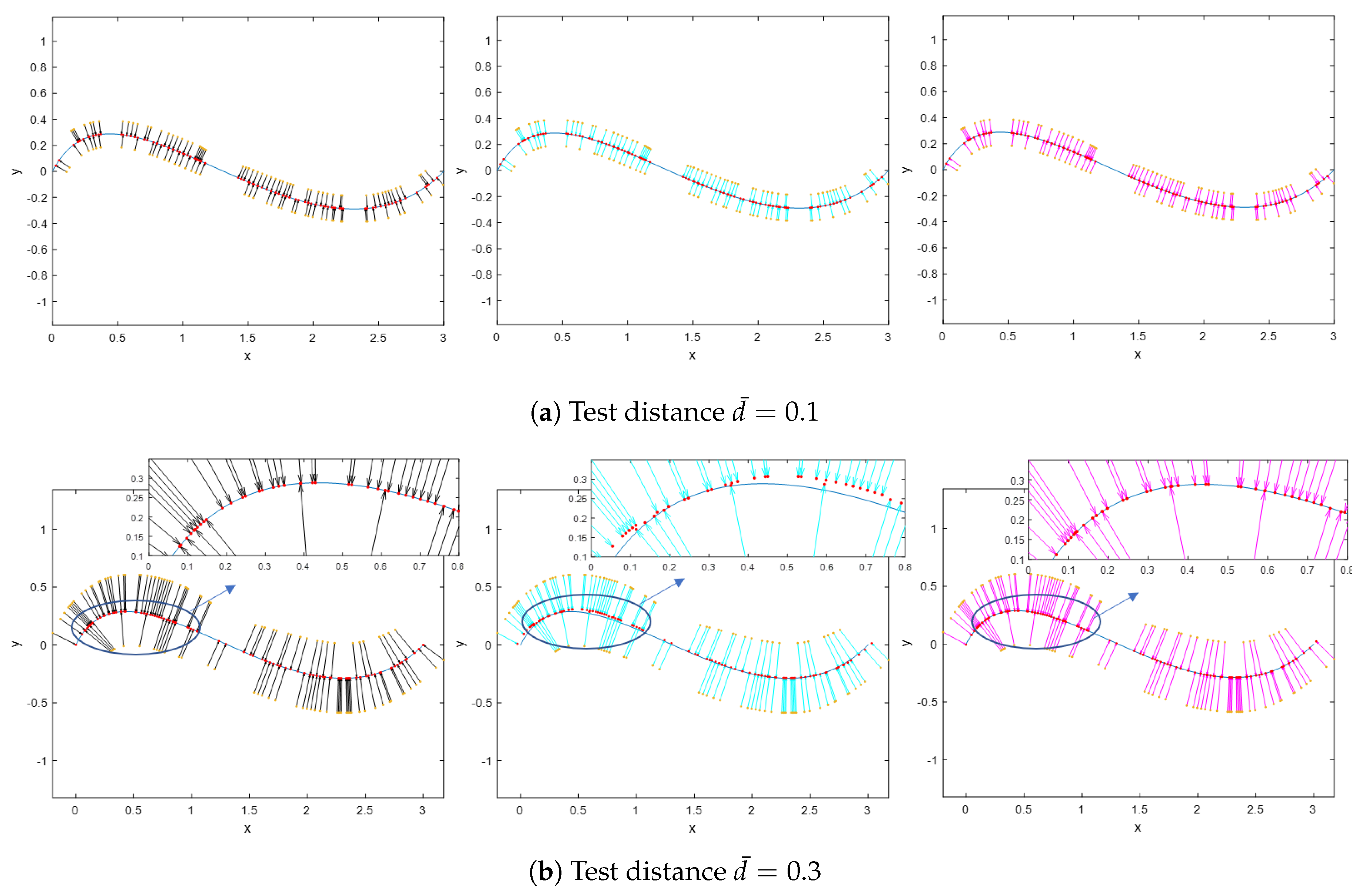
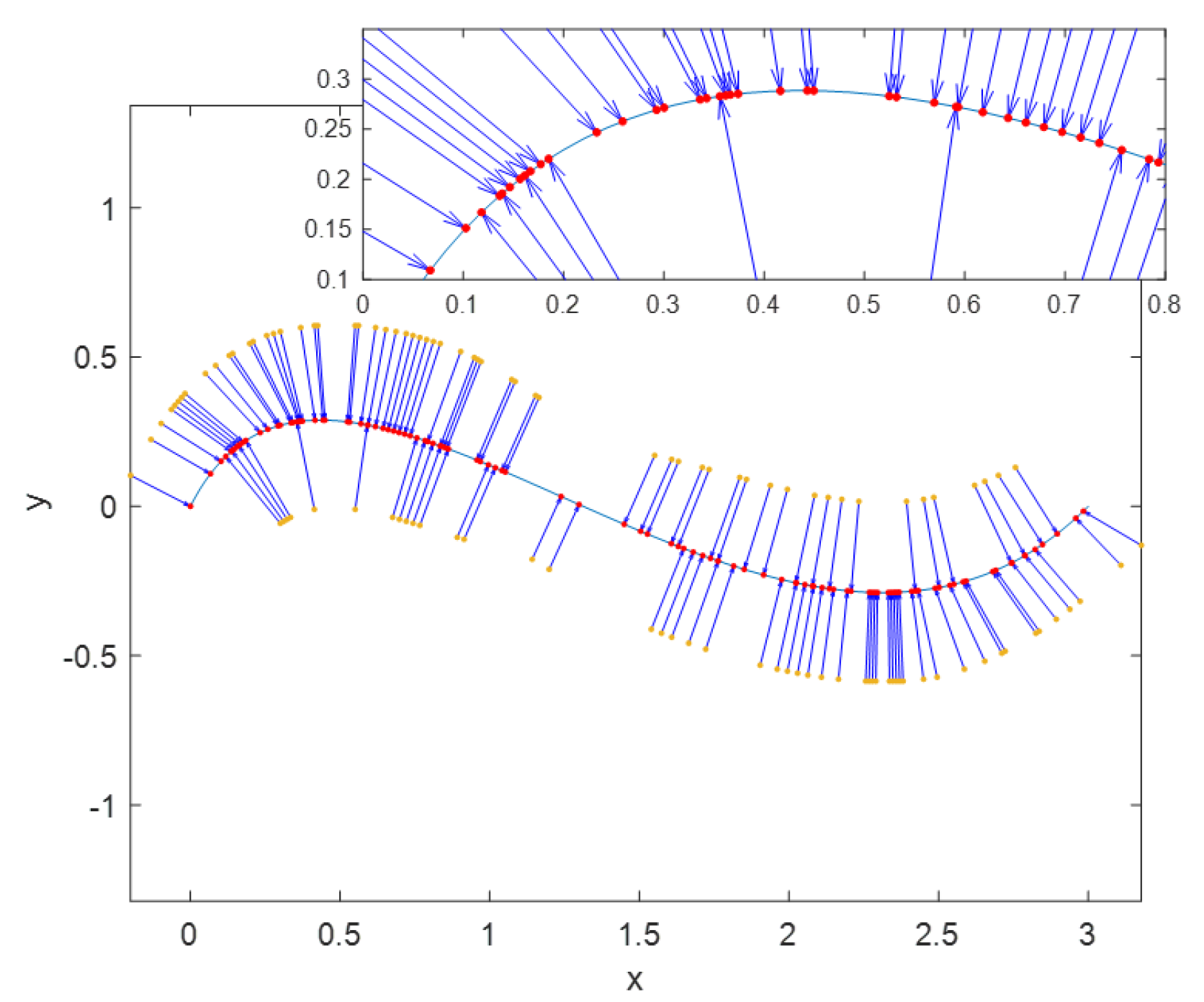
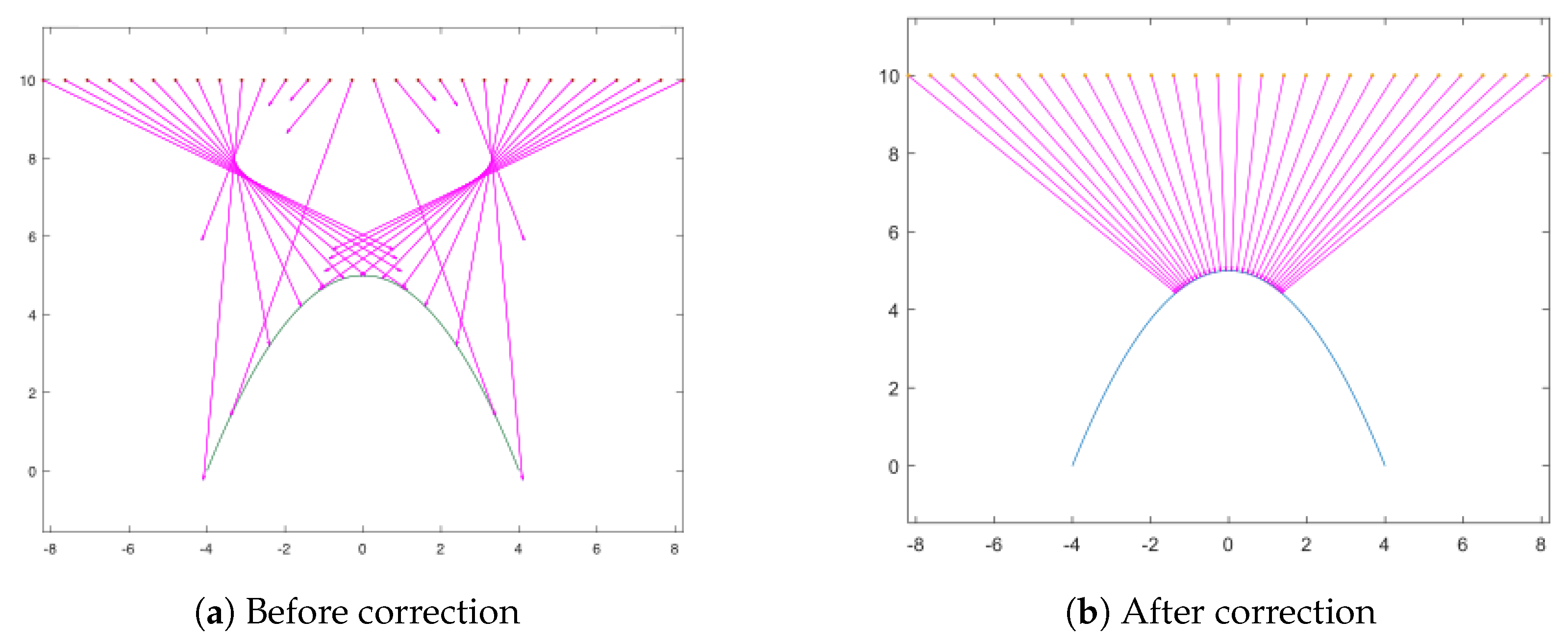

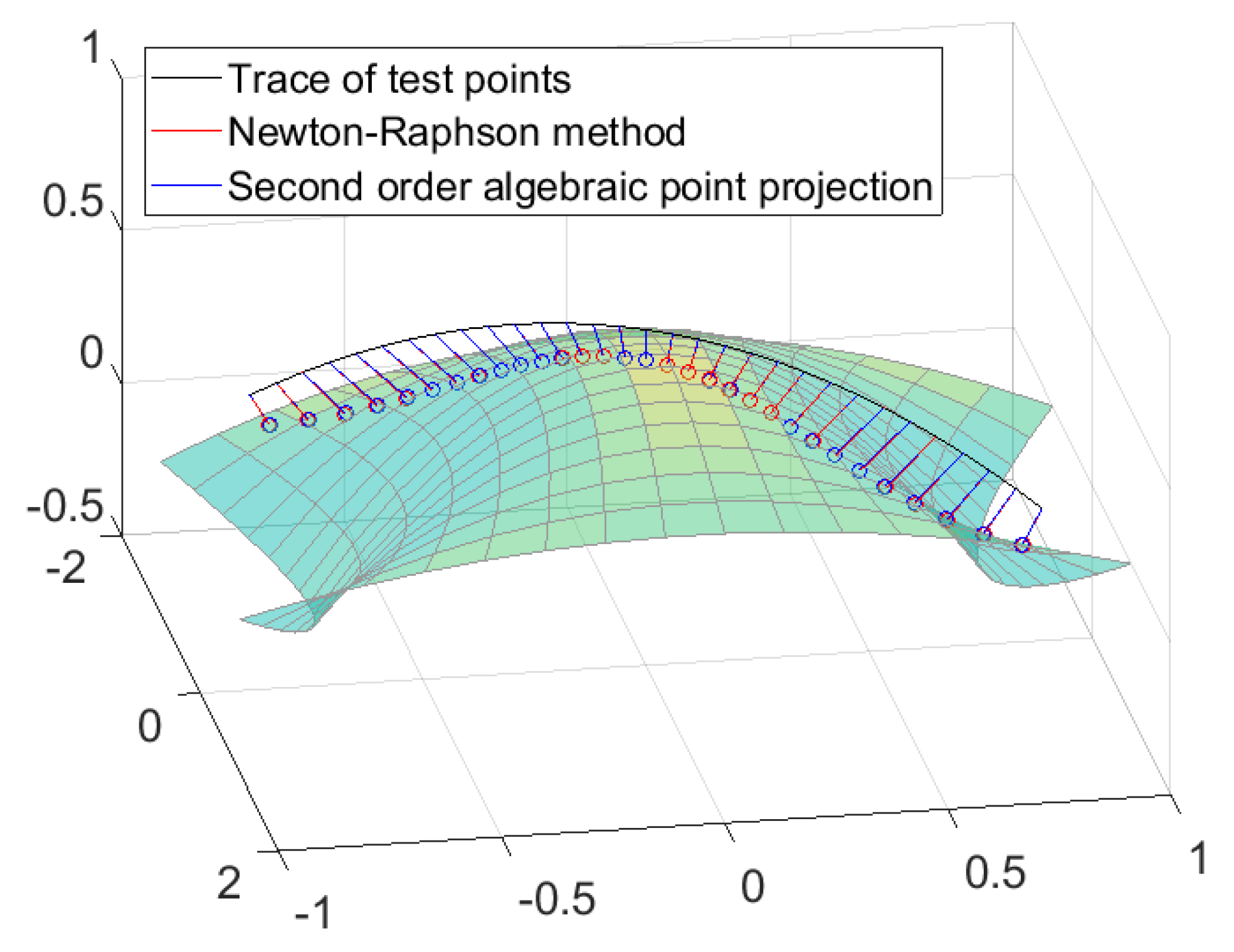
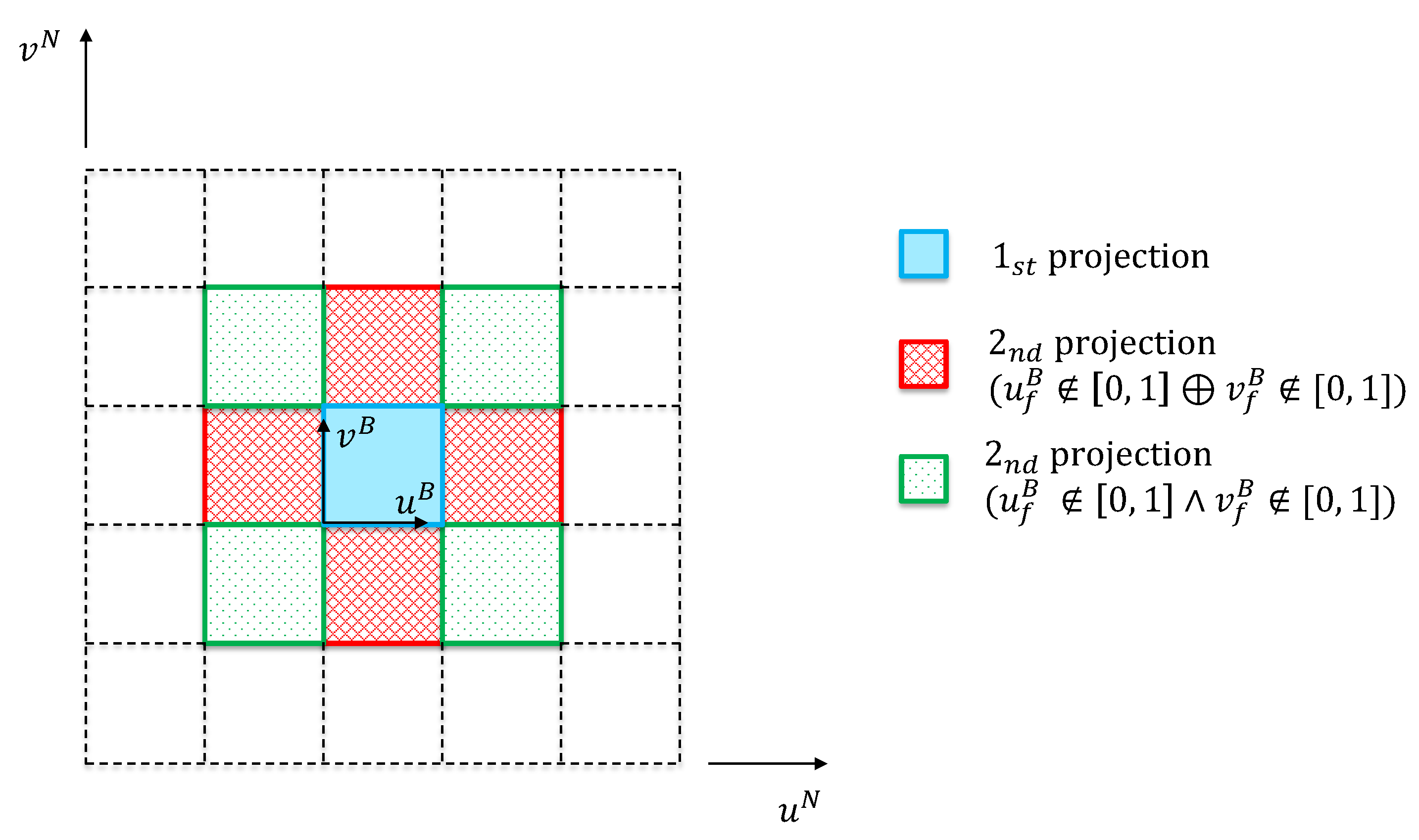
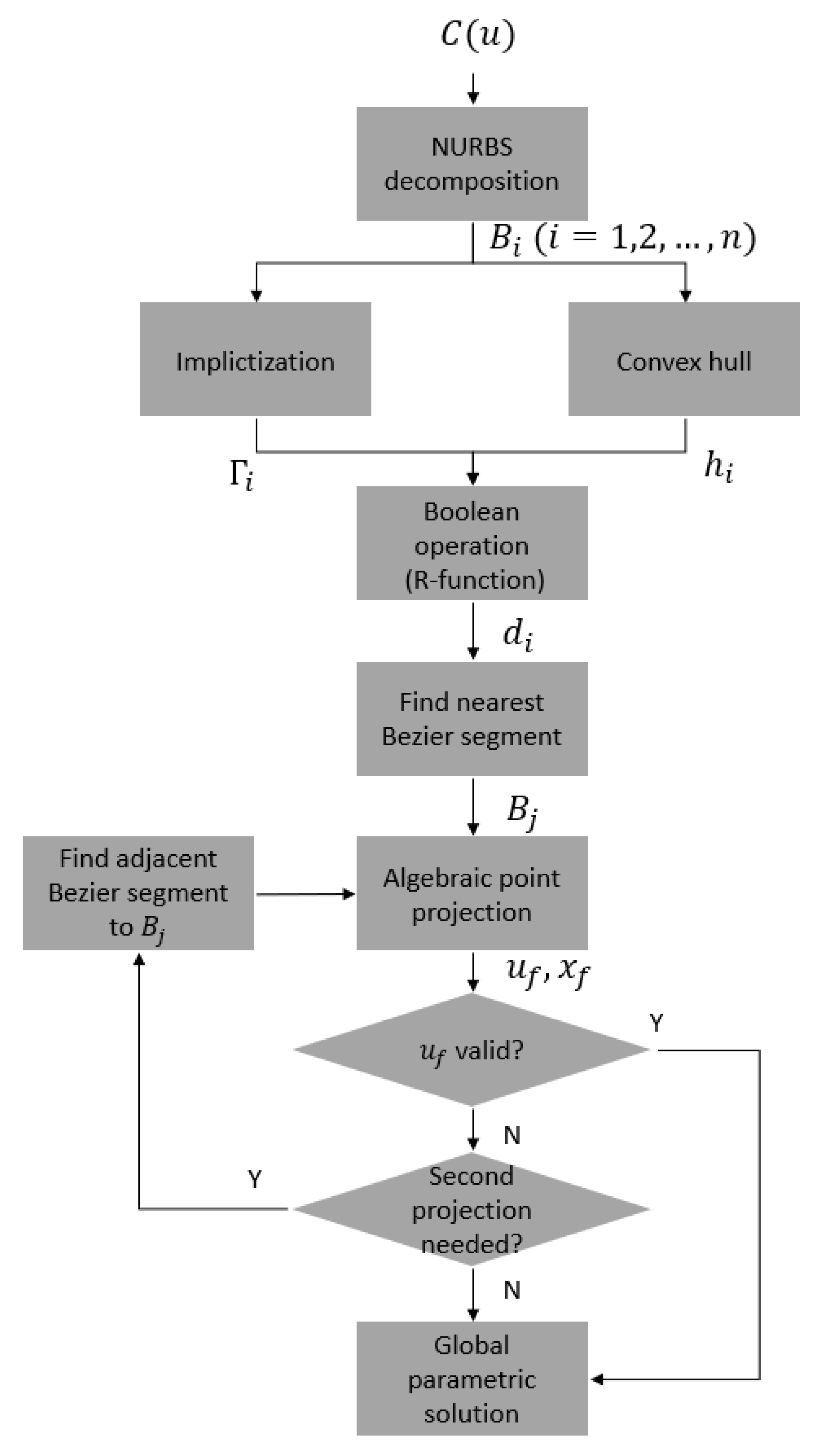
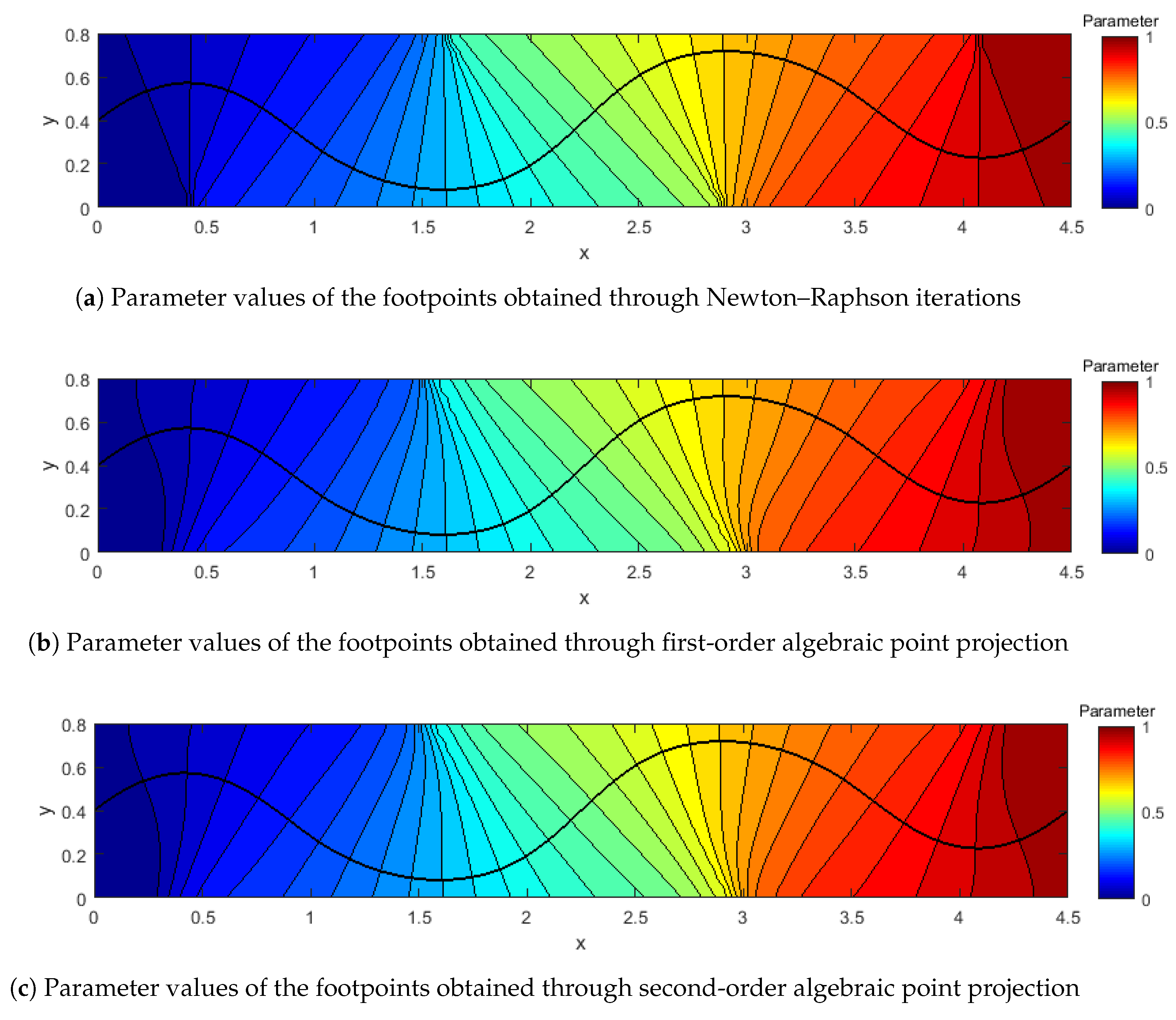
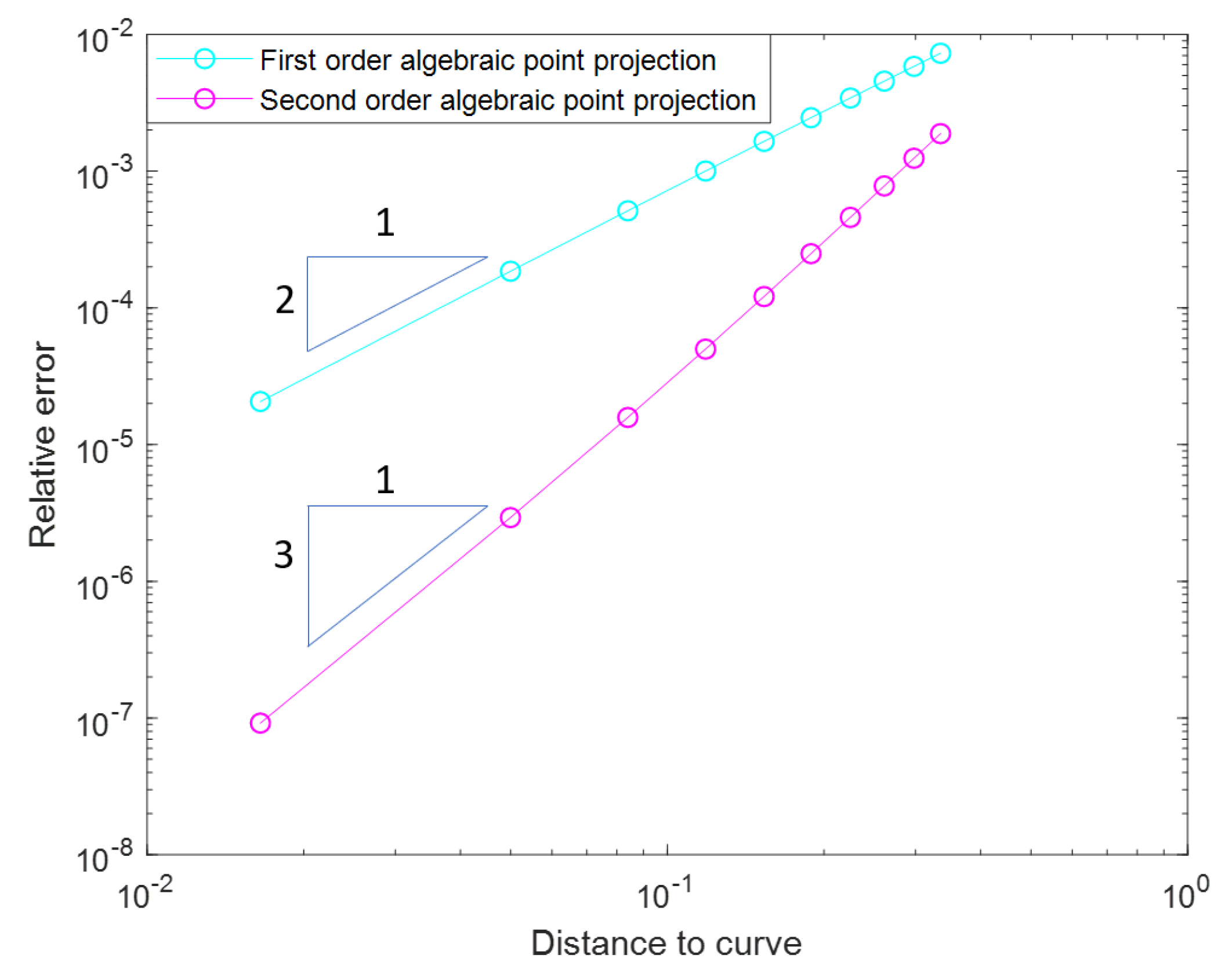
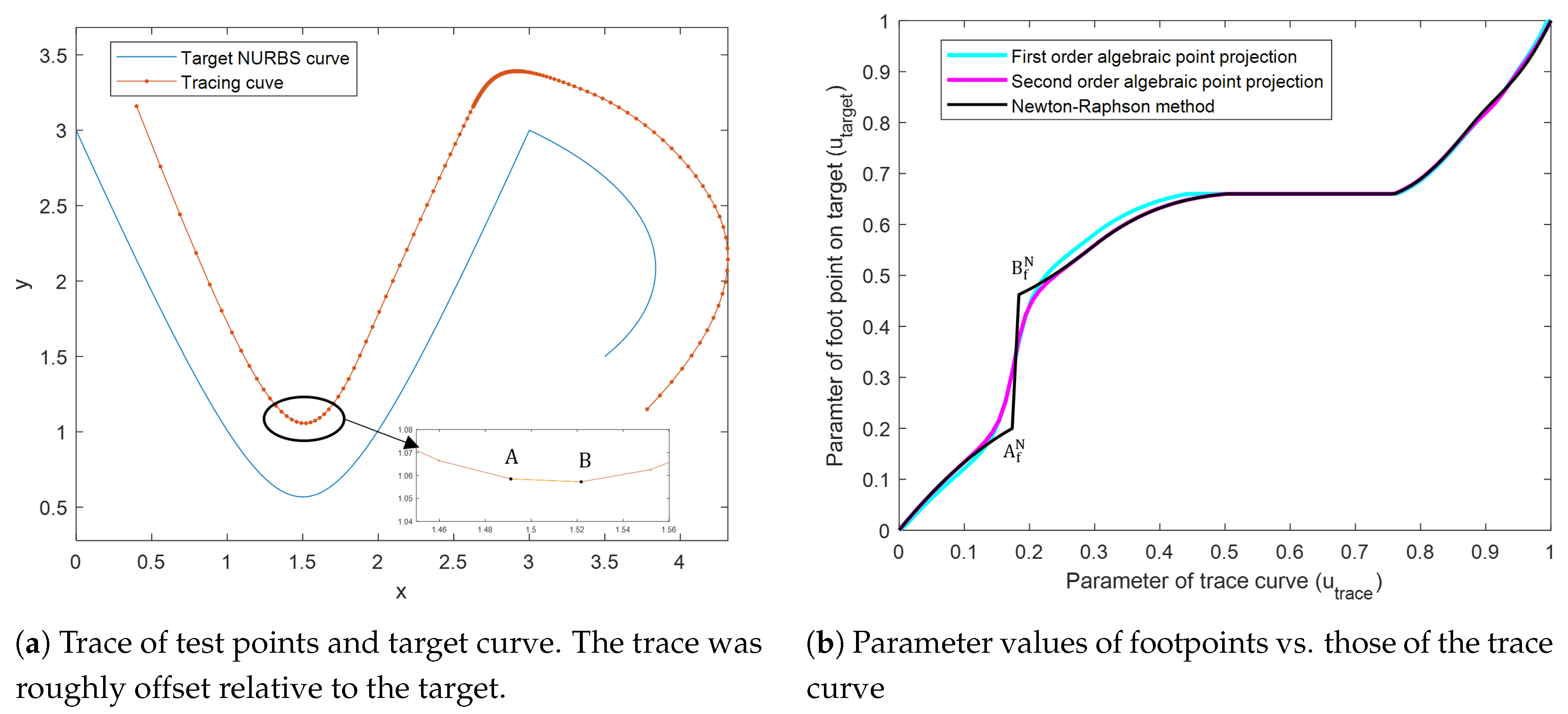
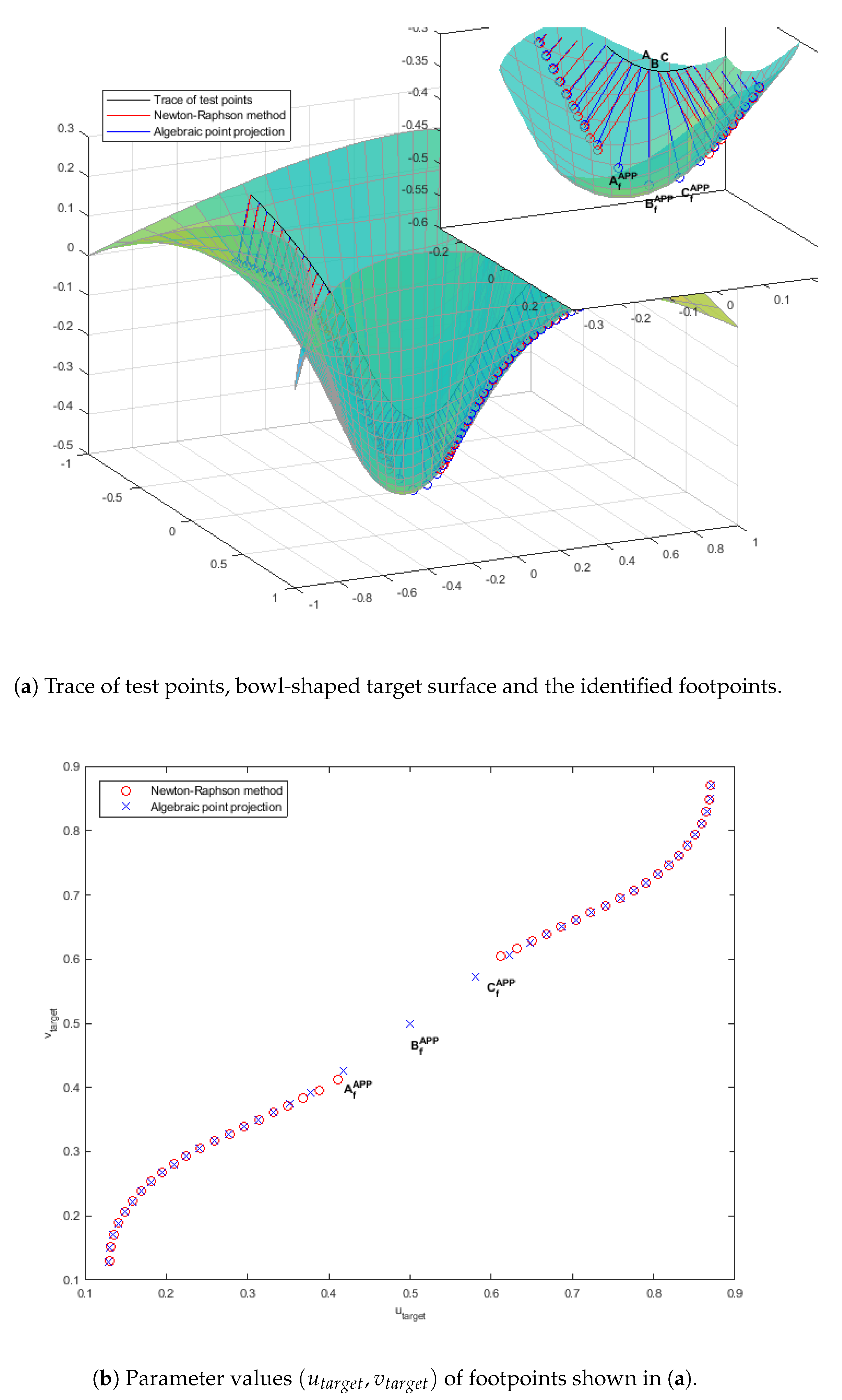
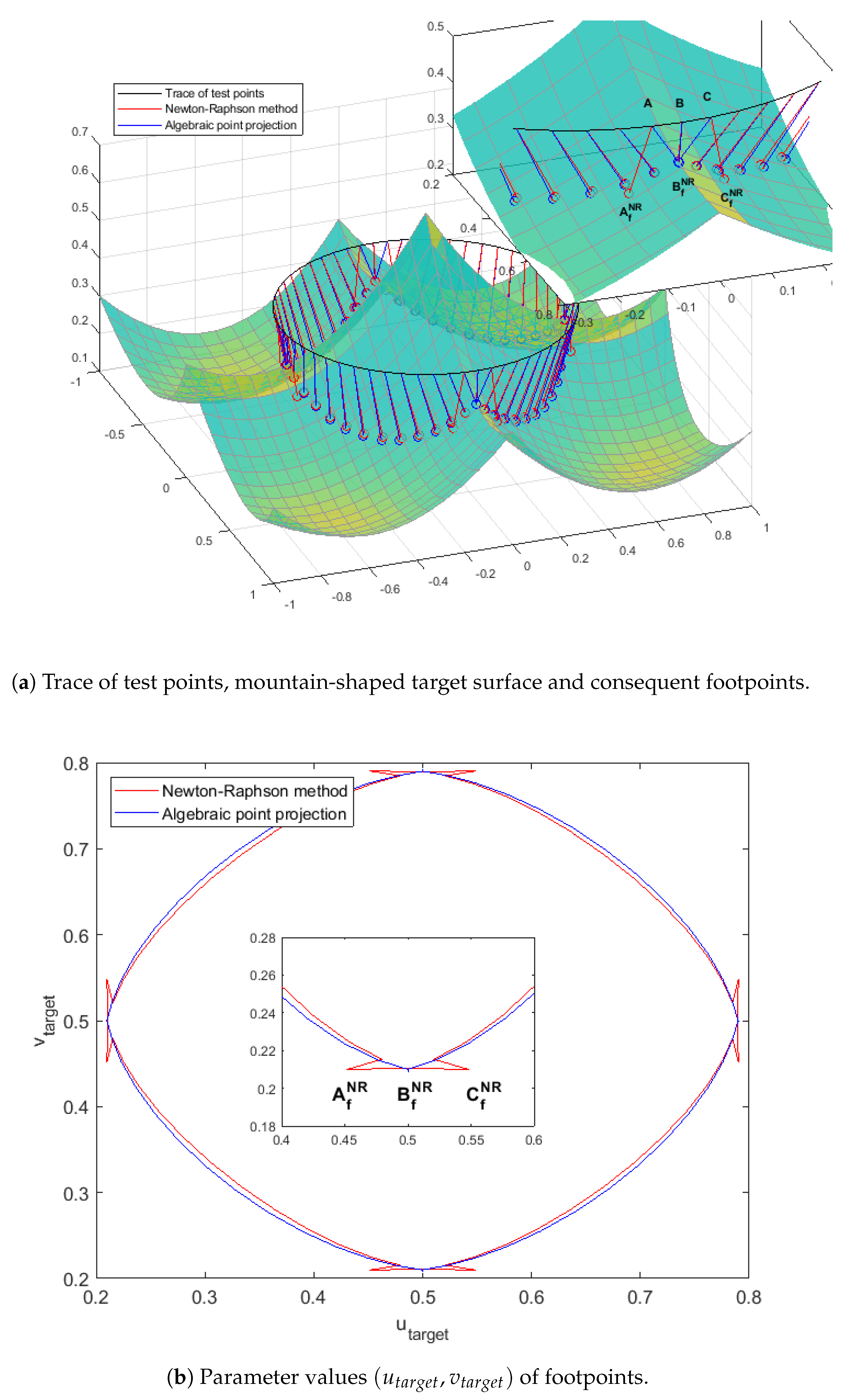
| Description | Reference | Algebraic | Initial Guess Dependent? | Efficiency | Accuracy | Smoothness |
|---|---|---|---|---|---|---|
| Subdivision method | [22] | Yes | No | High | Medium | No |
| Subdivision method + Newton–Raphson method | [12,14,15] | No | Yes | High | High | No |
| Geometric iteration method | [16,17,18,19,20,21] | No | Yes | High | High | No |
| Proposed method | Yes | No | High | Medium | Yes |
| Step | Time Complexity | |
|---|---|---|
| Curve | Surface | |
| Convex hull construction | ||
| Distance field of convex hull | ||
| Computing Dixon resultant | ||
| Normalization of resultant | ||
| Trimming operation | ||
| Step | Time Complexity | |
|---|---|---|
| Curve | Surface | |
| Computing algebraic level set | ||
| Determining the closest Bézier segment | ||
| Projection in physical space | ||
| Point inversion to parametric space | ||
| Scaling and offset | ||
| Example Surface | Newton–Raphson Iterations | 2nd order APP | |||
|---|---|---|---|---|---|
| Time per Point (s) | Average Number of Iterations | Time per Iteration (s) | Time per Point (s) | Time per Point for Algorithm 1 (s) | |
| #1 (Figure 19) | 211.91 | 5.00 | 36.03 | 55.28 | 14.84 |
| #2 (Figure 20) | 769.73 | 10.85 | 50.47 | 107.88 | 16.92 |
© 2020 by the authors. Licensee MDPI, Basel, Switzerland. This article is an open access article distributed under the terms and conditions of the Creative Commons Attribution (CC BY) license (http://creativecommons.org/licenses/by/4.0/).
Share and Cite
Liao, H.; Vaitheeswaran, P.K.; Song, T.; Subbarayan, G. Algebraic Point Projection for Immersed Boundary Analysis on Low Degree NURBS Curves and Surfaces. Algorithms 2020, 13, 82. https://doi.org/10.3390/a13040082
Liao H, Vaitheeswaran PK, Song T, Subbarayan G. Algebraic Point Projection for Immersed Boundary Analysis on Low Degree NURBS Curves and Surfaces. Algorithms. 2020; 13(4):82. https://doi.org/10.3390/a13040082
Chicago/Turabian StyleLiao, Huanyu, Pavan Kumar Vaitheeswaran, Tao Song, and Ganesh Subbarayan. 2020. "Algebraic Point Projection for Immersed Boundary Analysis on Low Degree NURBS Curves and Surfaces" Algorithms 13, no. 4: 82. https://doi.org/10.3390/a13040082
APA StyleLiao, H., Vaitheeswaran, P. K., Song, T., & Subbarayan, G. (2020). Algebraic Point Projection for Immersed Boundary Analysis on Low Degree NURBS Curves and Surfaces. Algorithms, 13(4), 82. https://doi.org/10.3390/a13040082





